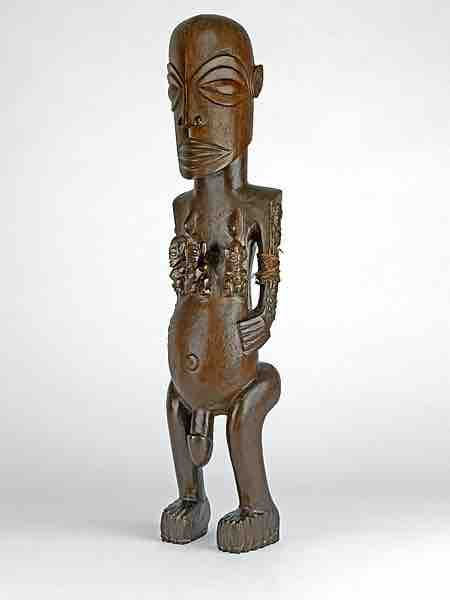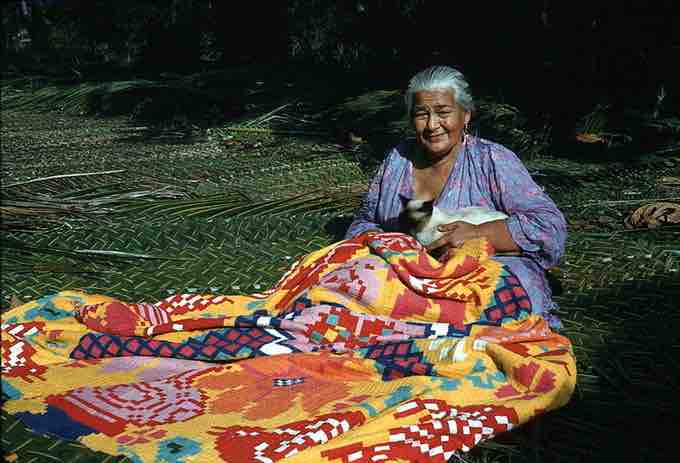Overview: The Cook Islands
The Cook Islands are a parliamentary democracy in the South Pacific Ocean in free association with New Zealand, composed of 15 small islands whose total land area is 92.7 square miles. Although Cook Islanders are citizens of New Zealand, they have the status of Cook Islands nationals, which is not given to other New Zealand citizens. The Cook Islands were first settled in the 6th century CE by Polynesian people who migrated from nearby Tahiti to the southeast. British navigator Captain James Cook arrived in 1773 and 1777 and named the islands the Hervey Islands; the name "Cook Islands", in honor of Cook, appeared on a Russian naval chart published in the 1820s.
Woodcarving in the Cook Islands
Woodcarving is a common art form in the Cook Islands. The proximity of islands in the southern group helped produce a homogeneous style of carving; however each island developed its own characteristics within this style. Rarotonga is known for its fisherman's gods and staff-gods; Atiu for its wooden seats; Mitiaro, Ma'uke, and Atiu for mace and slab gods; and Mangaia for its ceremonial adzes. Mangaia is the source of many fine adzes carved in a distinctive, idiosyncratic style with the so-called double-k design, and it also produces food pounders carved from the heavy calcite found in its extensive limestone caves. Most of the original wood carvings were either taken by early European collectors or were burned in large numbers by European missionaries.

Cook Islands carved wood figure, British Museum
The Cook Islands were regarded for their fine wood carvings, many of which were taken or destroyed by European missionaries.
Craftwork in the Cook Islands
Today, carving is no longer the major art form with the same spiritual and cultural emphasis given to it by the Maori in New Zealand. However, there are continual efforts to interest young people in their heritage. The island Atiu, in particular, has a strong tradition of crafts both in carving and local fiber arts such as tapa. The outer islands produce traditional weaving of mats, basketware, and hats. Particularly fine examples of rito hats are worn by women to church, which are made from the uncurled immature fibre of the coconut palm. The Polynesian equivalent of Panama hats, they are highly valued and are keenly sought by Polynesian visitors from Tahiti. Often, they are decorated with hatbands made of minuscule pupu shells which are painted and stitched on by hand. Although pupu are found on other islands, the collection and use of them in decorative work has become a specialty of Mangaia. The weaving of rito is a specialty of the northern island of Penrhyn.
Weaving in the Cook Islands
Weaved hand fan with a carved figure handle.
Another popular art form in the Cook Islands is tivaevae—the art of handmade Island scenery patchwork quilts. Introduced by the wives of missionaries in the 19th century, the craft grew into a communal activity, which is probably one of the main reasons for its popularity. By custom, a tivaevae is not measured by monetary value nor production cost: its value is said to be reflected by the love and patience that the creator(s) have put into making a stunning work of art. Cook Islands women often described their tivaevae as being "something from the heart. "

Woman sewing a tivaevae, Rarotonga
Tivaevae - the art o handmade patchwork quilts - is not measured by monetary value nor production cost, but rather is valued for the love and patience that the creator(s) have put into making a stunning work of art.
Contemporary Artists
The Cook Islands has produced internationally recognized contemporary artists, especially in the main island of Rarotonga. Artists include painter and photographer Mahiriki Tangaroa, sculptor Eruera (Ted) Nia (originally a film maker), master carver Mike Tavioni, and community-project artist Ani O'Neil. Many of these artists have studied at university art schools in New Zealand and continue to enjoy close links with the New Zealand art scene.
Marquesas Islands
The Marquesas Islands are a group of volcanic islands in French Polynesia, an overseas collectivity of France in the southern Pacific Ocean. The Islands form one of the five administrative divisions of French Polynesia. In the history of Marquesas Islands, the first recorded settlers were Polynesians, who, from archеological evidence, are believed to have arrived before 100 CE. Ethnological and linguistic evidence suggests that they likely arrived from the region of Tonga and Samoa. The islands were given their name by the Spanish explorer Álvaro de Mendaña de Neira who reached them on 21 July 1595. Much of Polynesia, including the original settlers of Hawaii, Tahiti, Rapa Iti, and Easter Island, was settled by Marquesans who were believed to have departed from the Marquesas as a result of overpopulation and drought-related food shortages. Much of the rest of Polynesia was colonized by Marquesan descendants centered in Tahiti.
These islands share similar artistic traditions of other Pacific Islands, including the art of tattooing. The Marquesas have a long history of complex geometric tattooing, covering the whole bodies of both men and women. Today, Marquesan culture is a mélange created by the layering of the ancient Marquesan culture, with strong influences from the important Tahitian culture and the politically important French culture.